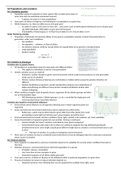Summary
Chapter 18 Populations and evolution textbook notes Unit 7 Genetics, populations, evolution and ecosystems Summary AQA Biology, ISBN: 9780198351771
- Institution
- AQA
Chapter 18 Populations and evolution notes from AQA A Level Biology (2nd edition). Authors: Glenn Toole, Susan Toole Publisher: Oxford University Press (including Nelson Thornes) with specification reference and exam questions at the end.
[Show more]




